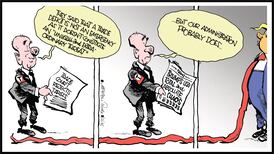Donegal councillor Frank McBrearty, whose father Frank owned The Parting Glass bar in Raphoe, this week lamented the demise of the Irish pub. The idea of the parting glass has taken on a new resonance in light of the recent report by the Drinks Industry Group of Ireland that reveals more than a quarter of all pubs in Donegal have closed since 2005 and that in the region of 1,900 pubs across Ireland have shut during that period. Raphoe has only two pubs still open; at one stage it had eight. As McBrearty sees it, the day of “the traditional bar where people came just to drink is gone”.
In truth, McBrearty’s assessment is just an updated obituary. What’s often referred to as the “traditional Irish pub” has been teetering on the edges of Irish community life for decades. As far back as 1969 Donal Connery, an American journalist, suggested: “The pub is a booby-trap for anyone trying to take a true measure of Irish life ... I will admit, as I write this, that it is painful to go against form and portray the Irishman as something other than a glorious drinker and an altogether devil of a fellow. Nonetheless, there are far more homes than pubs in Ireland and it is in the homes that one must look for the Irishman as he is most of the time.”
For all the attention devoted to drink and sociability, there was a dark undercurrent running through the testosterone-filled pub culture. The British anthropologist Hugh Brody observed west of Ireland male drinkers in winter in the 1970s huddled “closely in evident despair ... they exchange silence as if it were words”.
But the pub was more than that for much of the 20th century; it served a variety of different social and economic functions; it was where many did their business and formed a focus for community and social and political groupings, with the publicans acting as powerful local figures, sometimes dubbed Ireland’s “political landlords”. A revealing moment in the run-up to the introduction of the smoking ban in 2004 was when a Munster delegate at a Vintners Federation of Ireland national meeting asked, “who runs this country? We Do!” he answered himself. It was a crass, time-warp blunder.
That was during an era when, as Cian Molloy pointed out in his 2002 book The Story of the Irish Pub: “You can now order a traditional Irish pub from firms such as the Irish Pub Design and Development Company who will assemble your pub for you ... the company offers six stylistic choices: the cottage pub, the old brewing house, the shop pub, the Gaelic pub, the Victorian pub and the contemporary pub.”
In 1990 the Irish consumed 1.7 million cases of wine a year; by 2020 this had risen to more than 10 million cases and 80 per cent of the wine sold at that stage was being consumed at home
While the globalisation that transformed Ireland was gaining speed, the commodification of Irish pub nostalgia involved exporting the remnants of it. Other Celtic Tiger cultural shifts and patterns of social interaction were also relevant; as journalist Carissa Casey observed in 2007: “Economic prosperity has transformed Flann O’Brien’s infamous working man and his pint of plain into a harried office drone with a huge mortgage and a long commute. A crisp glass of Chablis in front of the widescreen is now the tipple of choice rather than the famed pint of porter in the cosy confines of a smoky bar.”
When American writer Bill Barich was researching his 2009 book, A pint of plain: Tradition, Change and the Fate of the Irish Pub, he was disappointed. Too many of them he regarded as “museum pieces” or in the business of manufactured nostalgia; why, he wondered, did he find himself amid a small group of Budweiser drinkers watching a soccer match while the barman spent his time sending text messages on his phone?
[ Kitsch Kitchen – Frank McNally on a Salthill institution, O’Connor’s Famous PubOpens in new window ]
There were about 11,000 publicans in Ireland 50 years ago when 75 per cent of all drinking was done in pubs; by 2013 an estimated 43 per cent of standard drinks were consumed at home. Today there are 6,800 pub licences in the Republic amounting to a pub for every 738 people in the country, still a high ratio (there is one pub for every 1,415 people in the UK). But our drinking culture has moved far beyond the horizons of the pub: in 1990 the Irish consumed 1.7 million cases of wine a year; by 2020 this had risen to more than 10 million cases and 80 per cent of the wine sold at that stage was being consumed at home.
Drink-driving laws, the absence of public transport networks in parts of the country, the smoking ban, increased costs, duties and prices, cheaper supermarket options, more focus on food consumption and the Covid crisis have been just some of the nails in the small pub coffin. Earlier this year, the president of the Vintners’ Federation of Ireland, John Clendennen, said “the Irish pub is a cultural institution”.
Such a claim is looking increasingly hollow.













